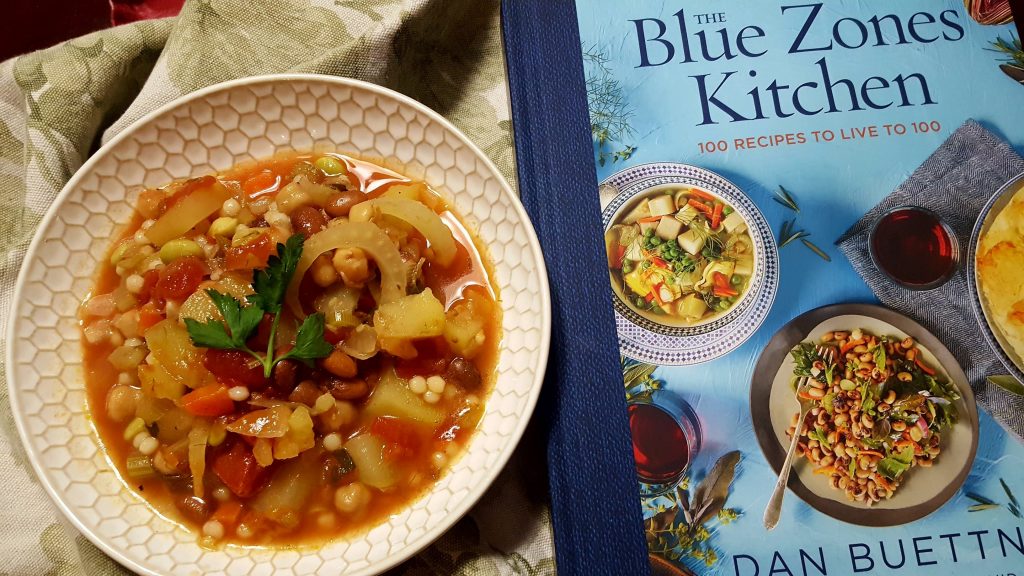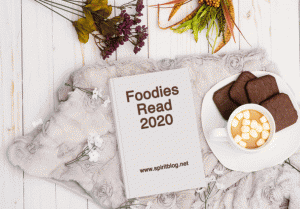It’s been a while since I have participated in a TLC Book Tour. My last stopover was for The Art of Escapism Cooking all the way back in October. I’m glad to have had the opportunity to receive a copy of The Blue Zones Kitchen for an honest review. (As always, all opinions and rants are my own.)

 About The Blue Zones Kitchen
About The Blue Zones Kitchen
• Hardcover: 304 pages
• Publisher: National Geographic; 1 edition (December 3, 2019)
Best-selling author Dan Buettner debuts his first cookbook, filled with 100 longevity recipes inspired by the Blue Zones locations around the world, where people live the longest.
Building on decades of research, longevity expert Dan Buettner has gathered 100 recipes inspired by the Blue Zones, home to the healthiest and happiest communities in the world. Each dish–for example, Sardinian Herbed Lentil Minestrone; Costa Rican Hearts of Palm Ceviche; Cornmeal Waffles from Loma Linda, California; and Okinawan Sweet Potatoes–uses ingredients and cooking methods proven to increase longevity, wellness, and mental health. Complemented by mouthwatering photography, the recipes also include lifestyle tips (including the best times to eat dinner and proper portion sizes), all gleaned from countries as far away as Japan and as near as Blue Zones project cities in Texas. Innovative, easy to follow, and delicious, these healthy living recipes make the Blue Zones lifestyle even more attainable, thereby improving your health, extending your life, and filling your kitchen with happiness.
Social Media
Please use the hashtag #bluezoneskitchen, and tag @tlcbooktours and @danbuettner.
Purchase Links
Amazon | Barnes & Noble | IndieBound
 About Dan Buettner
About Dan Buettner
Dan Buettner is the founder of Blue Zones, an organization that helps Americans live longer, healthier lives. His groundbreaking work on longevity led to his 2005 National Geographic cover story “Secrets of Living Longer” and two national bestsellers, The Blue Zones and Thrive. He lives in Minneapolis, MN. Visit him on Facebook, Instagram, and Twitter, and at his website bluezones.com.
What I thought…
I’ve been intrigued by the whole Blue Zones phenomenon for a while now so I was excited to receive a copy of The Blue Zones Kitchen. It’s a beautiful book, full of National Geographic quality photographs, not only of the food, but of the people who cook it in their environments.
As stated in the blurb above, these are areas where the life expectancy and health is above that found in the rest of the world. Their longevity experiences do go beyond food though. In these four areas—Sardinia; Okinawa; Loma Linda; Ikaria, Greece; and the Costa Rican Peninsula of Nicoya—it’s the entire lifestyle and sense of community.
People aren’t lonely, because it simply isn’t an option. If after a few days people don’t show up to the town festival, church, or even the village cafe, someone will generally check in on them. Electronic gadgets haven’t yet taken over. People talk face-to-face instead of on Facebook. (20)
Buettner also maintains that these communities are full of movers and shakers—they don’t set idle. They walk where they need to go and grow what they need to eat—“their surroundings nudge them into the right behaviors” (19).
It’s a great premise and full of ideas to ponder and act on.
As a cookbook, however, I have to offer a few suggestions to Buettner and his editors.
Let’s start with the structure. There is a table of contents that lists the recipes, but there is no index. I was wanting to start my cooking experience with this book off with a soup and I guess that because there was not an index to consult, I did find other recipes worth trying as I perused through the entire book.
Next, there’s the recipes themselves. So far, I have tried two recipes, neither needing any culinary expertise; however, I did need a working cooking knowledge to make them turn out.
It was definitely soup weather so I tried one of three hearty minestrone recipes from the Sardinian section.
Blue Zones Minestrone
The original recipe called for fava beans and cranberry beans. I substituted edamame and pinto beans, respectively.
Ingredients
- 3 T. extra-virgin olive oil
- 1 yellow onion, chopped
- 2 medium carrots, peeled and chopped
- 2 medium celery stalks, chopped
- 3 cloves garlic, minced
- 1 (28-oz.) can diced tomatoes
- 3 medium Yukon gold potatoes, peeled and diced
- 1 medium fennel, chopped (bulb, stalk, and fronds)
- 1/4 c. Italian flat-leaf parsley, chopped
- 2 T. fresh basil, chopped
- 1/2 c. frozen edamame (shelled)
- 1 (15-oz.) can pinto beans, drained
- 1 (15-oz.) can chickpeas, drained
- 6-8 c. water
- 1/2 c. Israeli couscous
- fine sea salt and fresh ground pepper
Instructions
- Warm 3 tablespoons of the olive oil in a large soup pot or Dutch oven set over medium-high heat.
- Add the onion, carrots and celery; cook, stirring often, until soft but not browned, about 5 minutes. Add the garlic and cook until fragrant, about 20 seconds.
- Stir in the tomatoes, potatoes, fennel, parsley and basil. Add enough water (about 6 to 8 cups) so that everything is submerged by 1 inch.
- Raise the heat to high and bring pot to a full boil. Reduce the heat to low and simmer slowly, uncovered, until the potatoes are done, about 20-30 minutes.
- Add the drained beans, frozen edamame and pasta. Return to a simmer and cook for 10-15 minutes or until pasta is done. Season WELL with salt and pepper. (Add more water if necessary).
Yield: 10-12
The flavor of this soup is fresh and delicious. I had a hard time following the directions (I’ve revised them here). I think things just got confusing whether you were using dried beans or canned. Also please know that you will need to use your largest soup pot.

I HUGE amount of minestrone!
This makes a lot of healthy and life-preserving soup. (It freezes well, too.)
The second recipe I made was from the Greek section: Parsley with Hummus (224). It is a very basic recipe without tahini as an ingredient. I honestly prefer hummus made like this. The ingredients are simple and straight forward: chickpeas, garlic, olive oil, red wine vinegar, and parsley. The directions (again) would have left one with a gloppy mess that didn’t resemble (at all) the accompanying photo in the book. But, if you knew to add the olive oil, vinegar, and the parsley to the food processor (along with a bit the Aquafaba, chickpea “juice”), you could have a very good hummus as I did.
The recipe states to sprinkle 1/4 c. parsley on top. The next time I make this recipe, I will add it to the food processor as well.
All-in-all, I enjoyed the book. I loved the stories and appreciated the resources at the end of the book: “How to Cook Beans” and the top longevity ingredients from each of the regions highlighted.
- Sardinia: barley, Cannonau wine (made from sun-stressed Grenache grapes), fava beans, kolhrabi, fennel, olive oil, potatoes, rosemary, sourdough bread, and tomatoes
- Okinawa: Imo (“supercharged” purple sweet potatoes), dashi broth, green onions, miso, sesame oil, bitter melon, seaweed and kelp, mushrooms, tofu, and turmeric.
- Nicoya: small sweet peppers, black beans, ground corn, cilantro, coconut, culantro (Mexican coriander), chilero sauce, papaya, squash (especially chayote), and yuca.
- Ikaria: Beans (especially chickpeas and black-eyed peas), fennel, wild greens (purslane, dandelion, arugula), lemons, olive oil, oregano, sage, rosemary, potatoes, and honey.
- Loma Linda: soy milk, Weetabix (an English whole grain cereal), corn flakes, brewer’s yeast, nuts, oatmeal, avocado, vegemite, beans, spinach
I would recommend this book, especially as a reference for starting and maintaining the Blue Zones diet. I would recommend it as a cookbook with the caveat that you may need to modify the recipe directions.

I just made the one-pot lasagna soup tonight (March 5). It was delicious and simple. Seek it out on page 274.
I am linking up with March’s Foodies Read as well as Kahakai Kitchen’s Souper Sunday. 

Announcing Novel Food #38:
Please note that Simona at bicriole is announcing Novel Food #38. You have until March 25th to link up.

Your minestrone looks great! I haven’t had one in a long while…kinda miss it! I too just made some hummus with just a few basic ingredients…simple and delicious!
I am making more of this hummus this weekend. I love it for lunch during the week!
Hadn’t heard about “Blue Zones” before. Or I guess I had heard of the concept, but not by that name. Anyway, this recipe looks wonderful (we love soup; LOVE IT!) so this book sounds like a winner.
I have tried one other soup (which actually was more delicious) from this cookbook. I want to try them all. (The latter soup recipe was better written.)
[…] Wednesday, March 4th: Eliot’s Eats […]
I’m glad you were on this tour, you always give great insight! Sara @ TLC Book Tours
Thanks for allowing me the opportunity, Sara!
Shades of the Mediterranean Diet that was so popular. I love the idea because all of the food is so darn good.
I was glad to get this book since my dr. told me I needed to start following the Med. Diet.
I hadn’t heard of Blue Zone before!
There’s lots more recipes online.
I love minestrone. The recipes look yummy.
Minestrone is a great comfort food!
I enjoyed this book–it’s so gorgeous. I have just made two recipes so far, one a soup of course but will be making more soon. Thanks for sharing your minestrone with Souper Sundays.
I can’t wait to see your reviews.
Over at our place, when a lot of various left-overs accumulate, guess what often comes? Yes, minestrone! I like the sound of some of the recipes mentioned and will check out the book from our library. Appreciate your honest report on it.
Soup is the perfect leftover accumulating accommodate!
This sounds like an interesting book. I must admit I had not heard the expression “Blue Zones” before. The minestrone looks great and I am sure works wonders when the weather outside calls for a hearty dish. Thank you so much for contributing to Novel Food 🙂
Glad to contribute!
[…] Wednesday, March 4th: Eliot’s Eats […]
Minestrone is one of my favorite soups and I enjoy that you chose that recipe for the roundups. Thanks for sharing!
This is a good versatile recipe, Cathy.